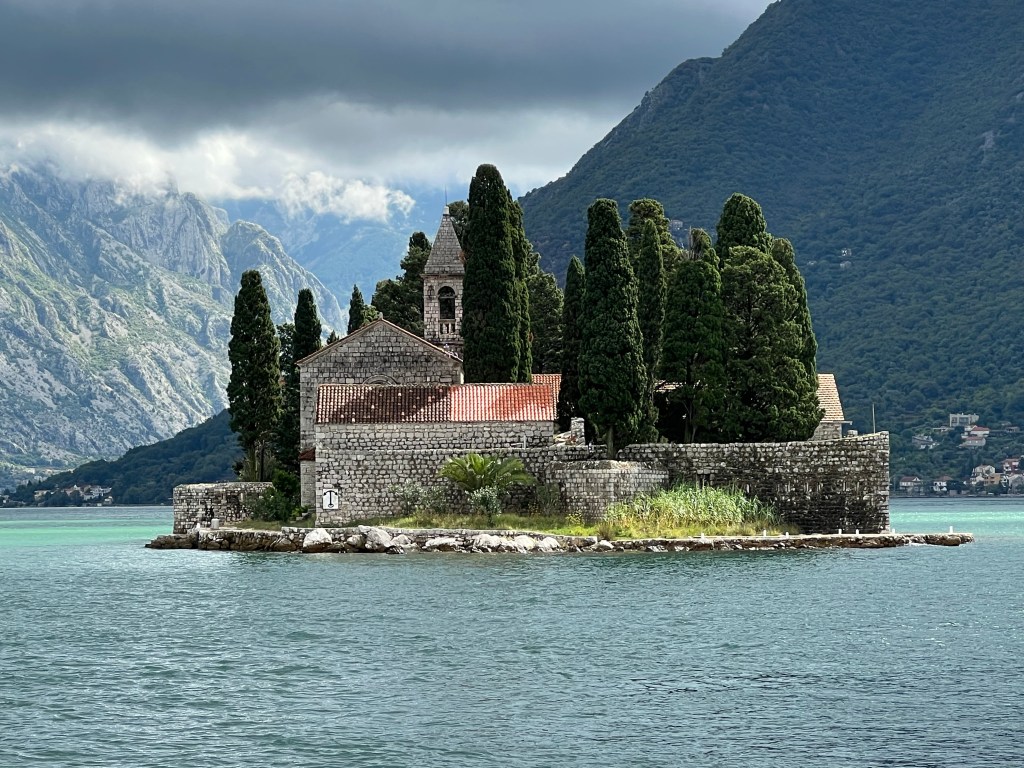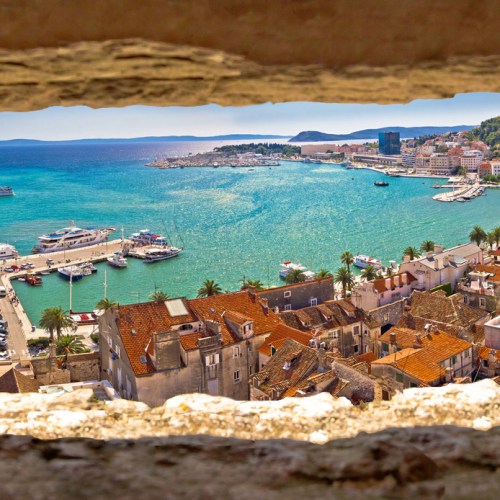
Table of Contents
Nestled along the Bay of Kotor, the charming towns of Perast and Kotor in Montenegro offer a perfect blend of history, culture, and stunning natural beauty. Just a short drive from Dubrovnik, this day trip will take you through picturesque medieval streets, past Venetian baroque palaces, and to a legendary islet chapel that draws pilgrims and tourists alike.
From the maritime treasures of Perast to the labyrinthine old town of Kotor, here’s a guide to making the most of your visit to these hidden gems of the Balkans.
Date of Visit: September 27, 2022
The dark clouds were spitting rain when we arrived near the sleepy town of Perast. A wiry, middle-aged man with the cadence of a carnival barker worked the trickle of cars pulling into the parking lot. We were barely out of our van before he began negotiating the fee to take us to Our Lady of the Rocks, the famous islet chapel, a Mecca of sorts for Catholic pilgrims and tourists who can bear to give up the charms of Dubrovnik for a day or two.
“Rick Steves was here. I took him on my boat and told him everything in his travel book.”
“Really!” I said.
“I am in the book. I will take you.”
We must have looked like Rick Steves fans. I thought my 2020 pre-Covid Rick Steves guidebook was in my luggage, but perhaps it was in plain sight on the back seat.
Our Circuitous Route to Montenegro
One thing is for sure: we looked like tourists in the conspicuous black Mercedes van that had taken us hundreds of miles from Zagreb, Croatia’s capital, to Ljubljana and Lake Bled in Slovenia and then back down the Croatian coast into Dalmatia.
Our road trip through the Balkans was a grand adventure. We didn’t expect such natural beauty and impressive architecture left by the Romans, Ottomans, and Venetians.
The day before, en route from Split to Dubrovnik, we stopped in Mostar, a picture-perfect, lost-in-time town in the mountainous country of Bosnia & Herzegovina. We saw old Ottoman bridges, mosques and minarets, and Eastern Orthodox churches, a sight you won’t see in many places aside from Sarajevo, also known for its religious diversity. Afterward, we visited Ston, Croatia, and climbed the ramparts high above the old town’s salt flats. We checked into our hotel in Dubrovnik, Croatia, that night, and today, we were squeezing in this day trip to Montenegro. We had yet to see Dubrovnik.


Scenic and Historic Montenegro
We wanted to see some of Montenegro, which is known for its rugged mountainous beauty. This country, with a Spanish name meaning Black Mountain, gained independence from Socialist Yugoslavia in 2006, but like much of the Balkans, it has a rich history dating back to the ancient Illyrians. There were once Greek colonies and Roman pirate-fighting expeditions that landed and left their mark (primarily in Doclea).
Many centuries after the southern Slavs arrived in the 6th century, the country, or parts of it, came under the control of outside powers, namely, The Republic of Venice and the Ottoman Empire. After World War II, the area we now call Montenegro merged with five other republics (including Croatia, Serbia, and Bosnia & Herzegovina) to become the Socialist Federal Republic of Yugoslavia led by Josip Broz Tito. For more detail, see the BBC’s timeline here.
Today's Itinerary: Perast and Kotor
We had arrived in the medieval town of Perast, just 1 1/2 hours by car from Dubrovnik, to see the legendary islet in the Bay of Kotor. After a quick visit to Perast, we planned to drive 15 minutes to the old town named after the bay. Our driving company had pre-booked a private tour guide to show us around Kotor, but here in Perast, we were on our own—well, almost.

A Deal Or A Steal?
After a rapid-fire exchange with the “barker,” our Croatian driver, Ivo, turned to us and said the boat ride to the island would cost 30€. At the time, I thought, thank goodness we have a negotiator because we have a target on our backs in Perast. Imagine my surprise when I looked up the fee on the Internet a few minutes ago. It says a trip by taxi boat to the island costs 5€ on the return, and 30€ can get you a boat ride to the island from Kotor. Perhaps the fee included parking (it was still high season). If so, I don’t mind as much, but there’s a sliding scale of gullibility, and beware, some enterprising folks are just waiting for your arrival.
After the extra 25€ changed hands (I’m still bothered by the perceived unfairness), Chris and I walked 10 minutes up the road to the harbor to find our boat. Perast is car-free, but a palanquin and porters would have been a nice touch for these two big-spending Americans. Ha!
Baroque Stone Palaces in Perast

Eventually, the old town of Perast came into view. A picture-perfect row of Venetian buildings in the Baroque style lined up along the water’s edge.
One captivating 17th-century building, the restored Bujović Palace (now a museum), boasts a wrought-iron balcony where I imagined a captain’s wife once watched for the return of her seafaring husband. Even here on Risan Bay (a smaller bay inside the Bay of Kotor), it could be dangerous when the cold winter Bora winds whip up to 160 miles per hour. Fortunately, the bay this day was like glass.
Two men, jawing on the dock, motioned us onto a small craft with a canopy. We weren’t sure this was the right boat and grew even more doubtful as we sat for 15 minutes, waiting for the “barker” to attract more tourists. None arrived, and without a word, one of the men leaped into the boat, started the motor, and navigated us over the crystal-clear water toward Our Lady of the Rocks.

Things To Do In Perast:

Looking back, we could see many of the 19 stone palaces that once housed the town’s nobility, mostly patrician clans and sea captains, who gained prominence when this fishing port took on a strategic trading role under the Venetians, who feared the Ottomans.
Low-hanging clouds obscured the top of the dark mountain that rose steeply behind the red-roofed town. It’s known as St. Elijah Hill, but at 2,864 ft, it’s a mountain, not a hill. The clouds made it look like Mt. Everest, creating a moody backdrop for our visit to Perast.
If you have the time, consider a walk around Perast or hiking the “hill” for some epic views.
Our Lady of the Rocks
A short boat ride from Perast, Our Lady of the Rocks is a must-see.
Legend has it that on July 22, 1452, two sailors from Perast discovered an icon of the Virgin Mary on a small rock in the Bay of Kotor. One of the sailors was unwell, and after finding the icon, he miraculously recovered. Interpreting this as a sign, the sailors tried to bring the icon back to Perast, but it kept returning to the rock where they found it.


Believing this to be a divine message, the townspeople of Perast started a tradition of throwing stones into the sea at the site of the rock. Over time, they also sank old ships filled with rocks to create a stable foundation. This practice, known as “fašinada,” continues to this day, with an annual celebration on July 22 where locals throw stones into the water to maintain the islet.
Eventually, the accumulation of stones and sunken ships led to the formation of an artificial island. In 1630, the locals built a Catholic church dedicated to Our Lady of the Rocks (Gospa od Škrpjela). The church houses a 15th-century icon of the Virgin Mary and symbolizes faith and perseverance for the people of Perast.
A small museum behind the church showcases a collection of paintings, votive tablets, weapons, and a tapestry embroidered with gold and silver threads by a local woman who wove in her hair. The islet offers stunning views of the bay and the surrounding mountains, making it a serene and picturesque destination.



Perast Museum in Bujović Palace
Located in the Bujović Palace, the Perast Museum offers a fascinating glimpse into the town’s rich maritime history. The museum features a collection of artifacts, paintings, and historical documents that chronicle Perast’s maritime past.
Visitors can explore exhibits that include antique weapons, traditional costumes, and navigational instruments used by Perast’s famous sea captains. The museum also offers breathtaking views of the Bay of Kotor from its terrace.

Church of St. Nicholas
The Church of St. Nicholas, built in the 17th century, is one of Perast’s most iconic landmarks. Intricate stonework adorns the church’s baroque façade, and its interior features beautiful frescoes and religious icons.
The adjacent bell tower offers visitors the chance to climb to the top for a panoramic view of Perast and the surrounding bay. The climb is steep, but the reward is a stunning vista of red-tiled roofs, the shimmering water, and the majestic mountains.

Smekja Palace
Once home to the prominent Smekja family, this palace is a testament to Perast’s affluent trading past. The palace’s grand architecture, complete with ornate balconies and a coat of arms on the façade, reflects the wealth and influence of its former inhabitants. Today, a luxury hotel, its exterior is a splendid example of Venetian baroque style and is perfect for a photo opportunity.
St. Anthony's Church
Located slightly off the beaten path, St. Anthony’s Church is a charming, small chapel dedicated to St. Anthony of Padua. The church’s interior features beautiful religious art, and its peaceful location offers a quiet spot for reflection.
Arrival in Kotor

After visiting Perast, we drove the short distance to Kotor, a historic town at the end of a secluded bay surrounded by steep limestone cliffs. Kotor’s charm lies in its labyrinthine streets, ancient buildings, and the imposing fortifications that have protected it for centuries.
A Walk Through History
Our private guide met us at the main gate of the old town, which dates back to the 9th century. We began our tour in the Square of Arms, the largest square in the town, surrounded by palaces, clock towers, and centuries-old buildings. Our guide pointed out the influences of different cultures that have shaped Kotor, from the Romans and Byzantines to the Venetians.
Sadly, a devastating earthquake in 1979 damaged many historic buildings and nearly half of the churches in Kotor. The epicenter was in the Adriatic Sea, but small Montenegro towns such as Kotor, Budva, Risan, and several hundred villages suffered severe damage. UNESCO helped restore the historic urban areas in what is now called The Natural and Culturo-Historical Region of Kotor.
St. Tryphon's Cathedral
One of the highlights in Kotor is St. Tryphon’s Cathedral, a Romanesque masterpiece built in 1166. Interestingly, it’s a Roman Catholic church in a predominantly Eastern Orthodox town.
This cathedral, dedicated to Kotor’s patron saint, boasts intricate stone carvings and frescoes that have withstood the test of time.
Inside, we admired the relics of St. Tryphon and the stunning altarpiece.

Maritime Museum in Kotor
The 18th-century Grgurina Palace houses Kotor’s Maritime Museum. This museum showcases Kotor’s rich maritime history with exhibits of model ships, navigational instruments, and artifacts from various periods. The guide shared stories of famous Kotor sailors and the town’s significant role in maritime trade.
Charming Streets and Squares
We continued our tour through Kotor’s narrow streets, discovering hidden squares and charming corners. We walked past the Church of St. Luke, a small but beautiful 12th-century church, and the Church of St. Nicholas, known for its impressive iconostasis. Both are Orthodox churches. The town’s blend of Gothic, Renaissance, and Baroque architecture was evident at every turn.

Climbing the City Walls
You can climb the ancient city walls for a panoramic view of Kotor and the bay. The ascent is steep, but many brave souls believe the vistas are worth every laborious step. The walls, which stretch for over 2.5 miles, offer a glimpse into Kotor’s strategic importance in the past.
Chris and I had enough time to snap a breathless photo from below.


This post is the 18th of my 19-part Balkan series that began with Road Tripping on the Balkan Peninsula in September 2022. There, you will find our itinerary to help you plan your trip.
- Ratings are based on 1) Natural Beauty 2) Unique Activities 3) Old World Charm














7 Comments
Wow, it seemed like you packed a lot of Montenegrin adventure in! I decided to stay in Perast for a week and found it was a good base.
A week! I imagine Perast would be a great base to savor a place like Montenegro. I would love to explore more of the historic towns and country.
It’s close to Kotor as you know and easy to organise a trip to some the natural spectacles of north Montenegro. A small country with a lot to offer 🙂
I would pick Perast and visit Kotor from there, too. Kotor attracts the crowds, and, with more time, we’d have traveled north to see the landscapes you saw. You captured so much beauty in your photos. I wish I could have seen Ostrog Monastery and those views from the mountains. I’m curious about your thoughts on visiting Risan, and any other nearby towns we missed on this trip.
I didn’t visit Risan but the coast road offered some beautiful views over the bay on the way up north and back again. I’ve still more to see another time.
You saw so much in a day! We are planning a week in Montenegro later in the year
A week sounds perfect, Hannah. You’ll have time to sample the cuisine, try some wines and more oysters like you did on Croatia’s Peljesac Peninsula. I look forward to reading about your upcoming trip.
Discover more from Travel The Four Corners
Subscribe now to keep reading and get access to the full archive.
Continue reading